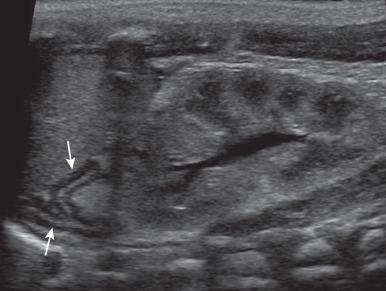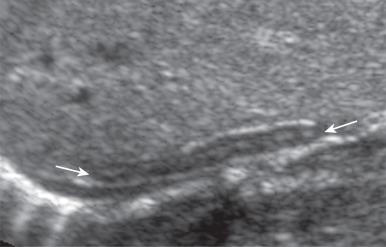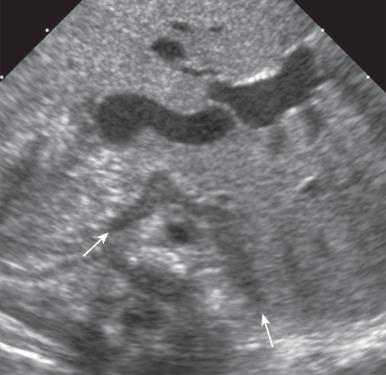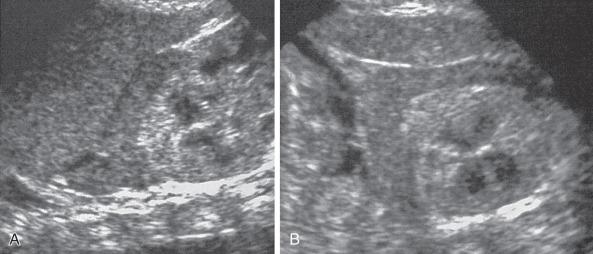Physical Address
304 North Cardinal St.
Dorchester Center, MA 02124
The adrenal glands in the neonate are easily visualized on ultrasonography; they are relatively large because of the presence of the fetal adrenal cortex, which accounts for about 80% of the gland ( Fig. 121.1 ).

On ultrasonography, the normal adrenal gland has a central hyperechoic stripe surrounded by a hypoechoic rim. The peripheral hypoechoic rim represents fetal as well as definitive cortex (see Fig. 121.1 ). The central hyperechoic stripe includes the medulla, the central veins of the adrenal, connective tissue, and the inner part of the fetal cortex. Morphologically, the normal adrenal gland has an inverted Y -shape. The surface of the adrenal gland is smooth or only slightly undulating. The easiest and most useful measurement of the adrenal gland is the limb width, which should normally be less than 4 mm.
Computed tomography (CT) and magnetic resonance imaging (MRI) are rarely required to visualize the adrenals in a neonate unless a mass is present.
A straight or discoid shape of the adrenal gland is seen on ultrasonography in association with certain congenital anomalies of the ipsilateral kidney, in which the kidney either is absent from its normal position in the renal fossa or is extremely small as a result of antenatal damage and dysplasia. The adrenal gland otherwise develops normally but assumes a flattened, discoid shape ( Fig. 121.2 ). The adrenal retains its normal pattern of echogenicity. Straight adrenal glands are longer than otherwise normal glands, and they tend to be slightly thicker.

Horseshoe adrenal gland is a rare congenital anomaly in which the right and left adrenal glands are fused. It is often associated with anomalies of the kidneys and the central nervous system, asplenia with visceral heterotaxy, and other anomalies.
A horseshoe adrenal gland appears on ultrasonography as a band of normal adrenal tissue crossing the midline in the upper abdomen above the kidneys ( e-Fig. 121.3 ). The adrenal gland maintains normal echogenicity. The isthmus of the horseshoe adrenal gland usually passes behind the aorta, but in asplenia it usually passes in front of the aorta.

Adrenal congestion may occur in perinatal asphyxia or stress. On ultrasonography, the glands are enlarged but maintain their general overall shape and smooth surface ( Fig. 121.4 ). This usually occurs bilaterally but may be seen unilaterally or focally within one gland. Loss of the normal central echogenic stripe occurs, and the fetal cortex may become a broad band of slightly increased echogenicity. A very thin peripheral anechoic rim that represents the definitive cortex may be present. Follow-up ultrasonography may show development of focal hypoechoic areas that represent hemorrhage or infarction. The changes may be reversible and the sonographic pattern may return to that of normal adrenal glands in patients who survive.

Become a Clinical Tree membership for Full access and enjoy Unlimited articles
If you are a member. Log in here